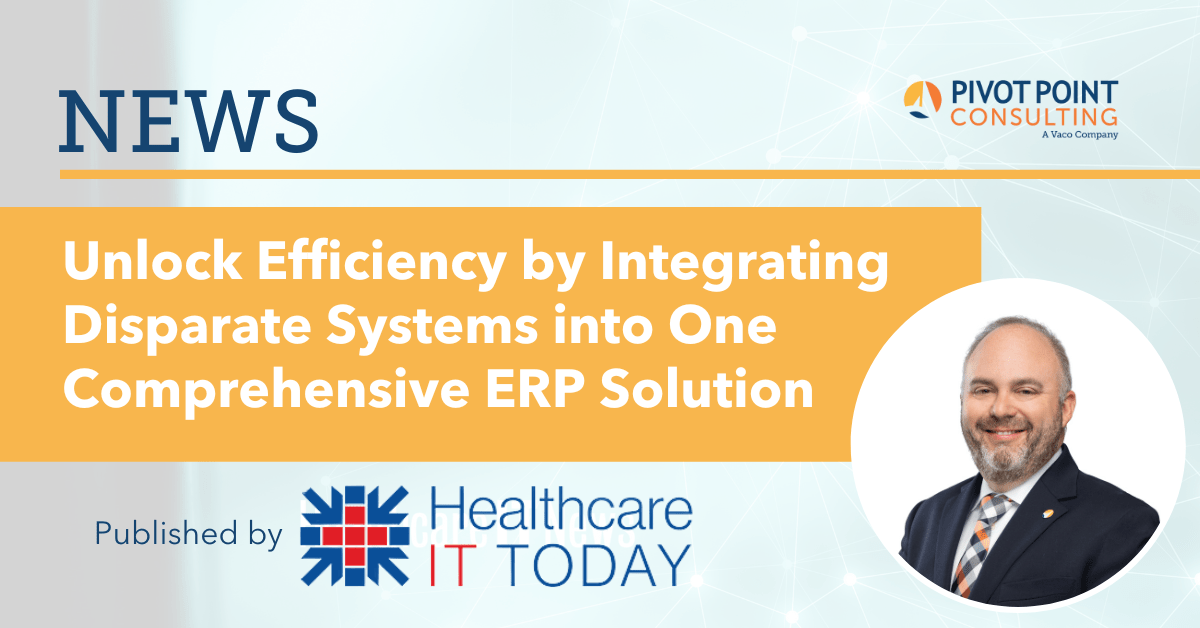Picture it: The year is 1995. You own a Palm Pilot PDA for scheduling, a flip phone for calls, and a digital camera for taking pictures. Back then these all were cutting-edge devices that made your job and life easier!
They also were point solutions that addressed only a specific need. Today we have smartphones, with the power of a supercomputer in the palm of our hands, that do all the above and more – find information, get directions, make purchases, play music and videos, perform calculations, provide weather updates, etc. These mobile devices have streamlined our lives by consolidating useful features and functionality into a single, user-friendly platform.
Unfortunately, healthcare in many ways is still stuck in the ‘90s. Too many healthcare organizations continue to deploy multiple enterprise resource planning (ERP) solutions to serve a specific need. They may have one system devoted solely to human resources, another to financial planning, another to the supply chain, another to payroll, and yet another for benefits administration, and more to cover all the various aspects of their business operations.
Running multiple ERP solutions creates more work for providers and payers, perpetuating inefficiencies that undermine business goals. Further, healthcare organizations using multiple ERP setups are missing out on the strategic and operational advantages of a unified, cloud-based ERP platform.
Below are three benefits healthcare organizations can derive from a single ERP system:
Unlocked efficiencies with one ERP system
ERPs that silo data make it harder for healthcare organizations to run efficiently, which can hurt margins and, ultimately, impact quality of care. Standalone systems hinder administrative processes, which creates more work for already overburdened healthcare staff, increasing the risk of turnover.
By deploying a single cloud-based ERP platform that is interoperable with other IT systems, particularly the electronic health records (EHR) platform, healthcare organizations can unlock unimaginable efficiencies that drastically reduce waste and redundancy in operations. This enables organizations to do more with less employees because 1) fewer systems specialists are needed and 2) basic-but-necessary maintenance such as software updates is performed for a single system instead of eight or 10.
There is, however, a caveat: your healthcare organization’s ERP must be well-designed and well-integrated with other systems to produce benefits. A poorly designed ERP can make things worse. Healthcare organizations should work with a trusted partner to plan, customize and develop their ERP implementation.
Higher employee retention
The Great Resignation – also called the Great Reshuffle — has left many healthcare organizations severely understaffed. It is critical, therefore, that providers and payers ensure their technology tools make it easier for employees to do their jobs.
Technology burdens are a major cause of burnout in the healthcare sector. Inefficient workflows, excessive and nonintegrated point solutions, and user-unfriendly digital tools consume an increasing share of healthcare workers’ time and energy.
A single, cloud-based ERP portal eliminates fragmentation issues that are endemic in environments with multiple ERP setups – each of which require separate logins. Liberating healthcare workers from retrieving information from disparate ERP systems improves employee engagement and satisfaction because employees no longer have to do frustrating work that should be avoidable or tedious jobs that leave them unfulfilled. Having a single ERP solution that serves associates’ comprehensive needs can drive enhanced employee engagement — a crucial metric for retaining talent.
A stronger supply chain
The pandemic devastated global supply chains in 2020, making it harder for healthcare organizations to find and obtain badly needed medical supplies to cope with the millions of COVID-19 patients flooding hospitals and clinics. And while a global health crisis can’t help but be disruptive, it also exposed weaknesses in the supply chains and demand forecasting of many healthcare organizations.
A cloud-based ERP system that integrates supplier data with demand planning platforms can help healthcare organizations avoid the lack of supply chain transparency that inevitably leads to unanticipated shortages or over-purchases. Artificial intelligence (AI) and machine learning (ML) can be used by providers to increase supply chain visibility, predict usage, reduce costs and respond instantly to sudden disruptions.
Conclusion: A single, unified ERP system
Healthcare organizations run on razor-thin margins. A unified, cloud-based ERP system that unlocks efficiencies, increases employee retention and strengthens the supply chain can make your healthcare organization financially stronger. Those increased savings may allow you to purchase an ambulance or a new MRI machine – money that otherwise would be eaten up by the process inefficiencies inherent in environments with multiple ERP systems.
Just as modern consumers no longer have to cart around five or six digital devices when they only need a smartphone, healthcare organizations do not have to struggle with multiple ERP systems that create chaos, inefficiency and extra work when a single cloud-based platform is available. It’s not 1995, after all.
Joe Clemons is the Vice President of ERP for Pivot Point Consulting. See the original article at Healthcare IT TODAY.


